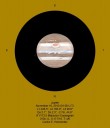Jupiter and Moons November 16, 2010
Sketch and Details by Carlos E. Hernandez
I made an observation of Jupiter on November 16, 2010 (01:00 U.T.). The Great Red Spot (GRS, center at 160.0* L2) was visible on the central meridian (CM). A good amount of detail was noted over the planet as described below. Io and Europa were visible close to each other over the preceding limb of the planet.
Date (U.T.): November 16, 2010
Time (U.T.): 01:00
L1 246.5*, L2 160.0*, L3 20.6*
De 2.1*, Ds 2.3*, -2.7m, 44.6” (Equatorial)
Instrument: 9-inch (23-cm) F/13.5 Maksutov-Cassegrain
Magnification: 310x
Filters: None (IL)
Seeing (1-10): 6-7, Antoniadi (I-V): II-III
Transparency (1-6): 4
Notes:
South Polar Region (SPR) to South Temperate Belt (STB): This portion of Jupiter’s southern hemisphere appears dark to shaded (3-6/10) containing irregular dusky (4/10) bands and shaded (6/10) zones with mottling noted throughout. The region between the South South Temperate Belt to the South Temperate Belt (STB) appears dark to dusky (3-4/10). Bright (7/10) ovals are noted over the South South Temperate Belt (SSTB) region. Oval BA appears dusky (4/10) and reddish-orange with a dark (3/10) collar preceding the CM. The following half of the South Temperate Zone (STZ) appears bright (7/10). The following half of the STB appears thin and dark to dusky (3-4/10) and containing dark (3/10) condensations.
South Tropical Zone (STrZ): Appears bright (7/10) and containing the Great Red Spot (GRS) on the CM. A dusky (4/10) streak appears to connect over the following end of the GRS which extends from the SEB region.
Great Red Spot (GRS): Appears shaded (6/10) over it’s center to dusky (4/10) over it’s periphery. Irregular dull (5/10) streaks were noted within. The preceding end of the GRS was measured at 150.9* L2 (11.6* L3), center (160.0* L2, or 20.6* L3), and following end at 166.0* L2 (26.7* L3).
South Equatorial Belt (SEB): Appears a dull to dusky (4-5/10) light pastel reddish-orange color with dusky (4/10) bluish-gray streaks throughout. The reformation of the Red Spot Hollow (RSH) appears to be taking place at this time.
Equatorial Zone (EZ): Appears bright (7/10) with dull (5/10) bluish-gray streaks noted within it. Dusky (4/10) bluish-gray festoon projections extending from the southern border of the NEB are visible within it.
North Equatorial Belt (NEB): Appears dark to dusky (3-4/10) with dark (3/10) condensations and bright (7/10) streaks noted within it. A very bright (8/10) rift is noted over the southern portion of the NEB towards the following limb which originates in the EZ. A dark (3/10) bluish-gray (almost lavender) elongated condensation is noted south of the bright rift. Dark (3/10) bluish-gray festoons (bases) are noted along the southern border of the NEB. Very bright (8/10) ovals are noted along the southern border of the NEB as well.
North Tropical Zone (NTrZ): Appears bright (7/10) and no other detail is visible within it.
North Temperate Belt (NTB): Appears thin and dusky (4/10) with a dark (3/10) condensation noted within it following the CM (172.1* L2 or 32.7* L3).
North Temperate Zone (NTZ): Appears bright (7/10) and no other detail is visible within it.
North North Temperate Belt (NNTB): Appears dark to dusky (3-4/10) and irregular.
North North Temperate Zone (NNTZ): Appears shaded (6/10) and no other detail is visible within it.
North North North Temperate Belt (NNNTB): Appears thin and dusky (4/10).
North North North Temperate Zone (NNNTZ): Appears thin and shaded (6/10).
North Polar Region (NPR): Appears dark to dusky (3-4/10) and mottled.
Europa (II, 5.80m) and Io (I, 5.52m), preceding to following, are visible close together (approximately two arc-seconds apart) preceding the planet at the level of the NEB.


Carlos,
Impressive work.
Frank 🙂
Carlos,
a really very detailed job both image and description.
Stefano